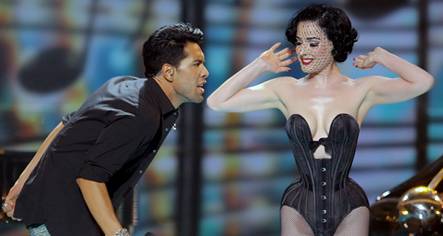A 23-year-old Norwegian, Alexander Rybak, won the contest in Norway’s third victory. Known as a Norwegian Harry Potter look-alike, Rybak was born in Belarus but grew up near Oslo.
German producer Alex Christansen was disappointed Alex Swings Oscar Sings! swing number “Miss Kiss Kiss Bang” didn’t finish in the top third, but pointed out that the duo at least did better than last year’s German entry, No Angels, the reunited girl band who placed dead last.
“We gave it all we had, there was nothing more. It was a world class show!” Christensen said.
Alex Swings Oscar Sings! brought along American burlesque dancer Dita von Teese in the hope she would titillate the audience and lift the duo’s ranking. The American dancer, who was once married to shock rocker Marilyn Manson, showed plenty of skin during the swing routine. Her outfit included metallic pasties on her breasts and a riding crop. During the performance, she even ripped open singer Oscar Loya’s shirt, but in the end it wasn’t enough to carry the night.
Germany wasn’t the only country to walk away disappointed from the night. The Turkish-Belgian singer Hadise’s belly dance routine did worse than expected. British sensation Jade Ewen also didn’t win as many UK fans had hoped despite being backed on the piano by musical king Sir Andrew Lloyd Webber.
The night was overshadowed by a violent crackdown by Moscow police against a gay rights demonstration Saturday afternoon. Authorities arrested 40 protesters on the grounds that the march lacked official approval.
Rybak criticised the authorities response to the protest, saying “we’ve had the biggest gay pride demonstration right here in this hall tonight.”
Russia spent a record €30 million to put on the Eurovision show. Over 20,000 spectators watched in the arena that also housed the 1980 Olympics. Over 120 million TV viewers from across Europe watched the show.



 Please whitelist us to continue reading.
Please whitelist us to continue reading.
Member comments